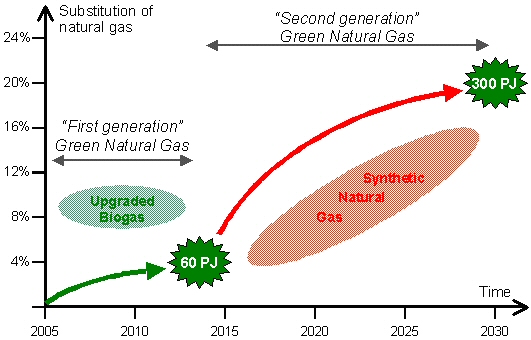SNG ambitions and implementation
The substitution of natural gas by a renewable equivalent is an interesting option to reduce the use of fossil fuels and the accompanying greenhouse gas emissions, as well as from the point of view of security of supply. The renewable alternative for natural gas is the so-called green natural gas, i.e. gaseous energy carriers produced from biomass comprising both biogas and Synthetic Natural Gas (SNG). For definitions of the gases see the table below. Via this route can be benefited from all the advantages of natural gas, like the existing dense infrastructure, trade and supply network, and natural gas applications.
Type of gas | Description |
Natural gas | - produced from gas fields; contains mainly CH4 |
Biogas | - produced by digestion, contains mainly CH4 and CO2 |
Landfill gas | - product of landfills, composition similar to biogas |
SNG | - Synthetic Natural Gas, contains mainly CH4 |
Bio-SNG | - SNG from biomass |
Green natural gas | - general term for both bio-SNG and upgraded biogas or landfill gas |
Syngas | - synthesis gas: H2 and CO (and CO2 and H2O) from fossil origin |
Biosyngas | - biomass origin, chemically similar to syngas |
Product gas | - produced via medium temperature (<1000°C) gasification |
The Netherlands has an excellent position to play an important role in the implementation of Green Natural Gas in Europe because of its logistic infrastructure (harbours for biomass import), biomass and natural gas knowledge positions, already widespread application of biomass in the power sector, and the most dense natural gas network in the world.
Within the Energy Transition activity of the Dutch Ministry of Economic Affairs, five Platforms are formed that concentrate on different sectors of the energy infrastructure. One of the transition platforms is dedicated to new gas options. This transition “Platform New Gas” has defined the ambition to replace 20% of the natural gas by green gas by 2030 [1]. A substitution target of 50% has been suggested for 2050. With a current annual (2004) consumption of natural gas in the Netherlands being approximately 1,500 PJ (which corresponds to 50 billion mn3), a 20% substitution would hence correspond to 300 PJ.
The potential of (upgraded) biogas and landfill gas in the Netherlands is maximum 60 PJ (i.e. 4% substitution) due to limited availability of suitable digestible feedstock materials. To reach the ambition of 20% substitution in 2030 a SNG production capacity is required of at least 240 PJ. Whereas digestion is an available and commercially proven technology with widespread implementation on farm scale, the technology for SNG production, however, is still under development and realisation of the first semi-commercial plant is not expected before 2010. In the figure below the green gas ambitions and implementation-in-time are schematically shown with both contributions of biogas and SNG. Due to the different time scales and complexity of the technologies, biogas can be considered as a “1st Generation” green natural gas, while SNG is the “2nd Generation” gas with an implementation in a later phase, but with a much higher potential.
To implement green natural gas in the Dutch energy infrastructure a phased approach is suggested. On the short term is started with the route of upgraded biogas produced by biological digestion of biomass materials like manure. The technology is available and can already be commercially applied in small-scale projects utilising locally available biomass. Typically, the biogas will be used directly for power production, mobility, or injection to a local low-pressure natural gas grid.
The main source of green natural gas on the long term, however, will be synthetic natural gas (SNG) that is produced via gasification of biomass and subsequent methanation of the product gas. In contrast to digestion requiring specific wet feedstocks, essentially all biomass materials are suitable as feedstock for gasification and the SNG route. Where the potential of biogas is limited to 60 PJ (4%), the potential for natural gas substitution by SNG is in fact 100%. A potential limitation might be set by the requirement for large amounts of biomass (see also discussion in next section). The large amounts of SNG would typically be injected to the high or medium pressure national gas grid.
References:
J. Gigler, H. Boerrigter, M. van Burgel, P. Cnubben, R. Hoogma and J. Wempe: Vol gas vooruit; De rol van groen gas in de Nederlandse energiehuishouding, startnotitie voor de werkgroep Groen Gas. On behalf of “Platform Nieuw Gas”, 20 June 2006, The Netherlands.
